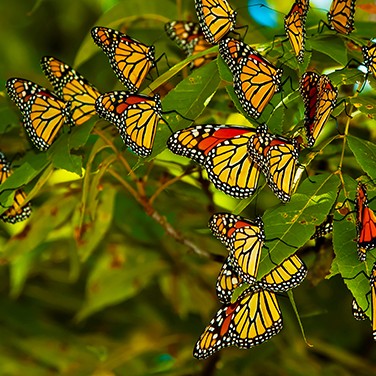Weird Signs of Autumn
By Christina Phillis
Falling leaves, shorter days, and lower temperatures are all common signs of autumn, but they aren’t the only indicators of the season change. Many animals, insects, plants, and even the sky have a way of letting us know that summer is over.
Insect Migrations
Monarch Butterflies
Birds are not the only living things that migrate during the fall season — several insects travel south. Monarch butterflies make a 3,000-mile journey from the U.S. and Canada to Mexico. Millions of monarchs can be seen huddling together on oyamel fir trees in the mountains of central Mexico. That tree canopy and ecosystem provide a microclimate and temperatures that help the butterflies thrive.
Unlike birds, these monarch butterflies never make the return trip. From Mexico, they stop in Texas to mate and lay eggs. When their offspring hatch and become adults, they travel north. It sometimes takes four or five generations to return as far north as Canada.
Tarantulas
The residents of Gabbs, Nevada, encounter mobs of tarantulas instead of beautiful monarch butterflies. This city is home to the world’s largest autumnal tarantula migration, where thousands of arachnids can be seen climbing screen doors and crawling along sidewalks and through houses in search of a mate.
Animal Mating
Not all animals hibernate during the winter. Many animals actively look for mates at this time. Visitors travel to Yellowstone National Park just to hear the bugle calls of bull elks in their mating season, also known as a rut. The call is described as “a guttural bellow, a shrill pitch, and a hollow grunting”.
At this time of year, mature bulls round up a harem of 30 or more females for breeding. The younger males call to challenge older males, who answer with much deeper and more dominant voices.
Bats also use their vocal cords to attract mates in the fall. Unlike elk, bat calls can be complex, featuring structured melodies, multiple syllables, phrases, repetition, and rhythm.
Plant Activity
While the shorter days and decreased sunlight cause some tree leaves to change color, shrubs that grow winter berries may be prompted to start growing. This is the result of photoperiodism, which causes living organisms to respond to changes in daily, seasonal, or yearly cycles of light and darkness. Plants that require less sunlight are referred to as short-day plants while those that require more daylight are considered long-day plants.
Mushrooms are also much more plentiful in the fall. They respond well to the warm and humid climate in the fall and feed on decomposing plants. As they consume plant materials, they recycle nutrients and create a form that is easier for other plants to absorb.
Solar and Lunar Events
Auroras
Some signs of autumn appear in the atmosphere and cosmos. Auroras or light displays are often most visible in the fall and springtime due to an increase in geomagnetic storms. During these storms, the Earth’s magnetic field vibrates in response to solar wind gusts. When the Earth’s higher latitudes face the sun and the sun’s rotational axis is tilted, the Earth has the most exposure to the sun’s poles and solar wind.
The protective magnetosphere layer around the Earth is also filled with electrons and protons. When a solar gust hits the magnetosphere, it releases trapped particles that rain down on the atmosphere and create a glow where they hit. From Earth, they appear as wavy green and pink clouds in the sky.
Harvest Moon
Another sign of fall in the sky is the harvest moon. Sunsets occur earlier as the moon rises later and the days get shorter. When the moon rises at the same time as the sun near the time of the autumn equinox, we see a large orange-red circle in the sky. The moon looks red because it is closer to the horizon and the thickest part of the atmosphere, which absorbs blue light and transmits red light. And, although the moon always appears larger when it’s near the horizon, this is just an optical illusion.
Watch and listen carefully, and you’ll see and hear the signs and sounds of autumn all around you.
